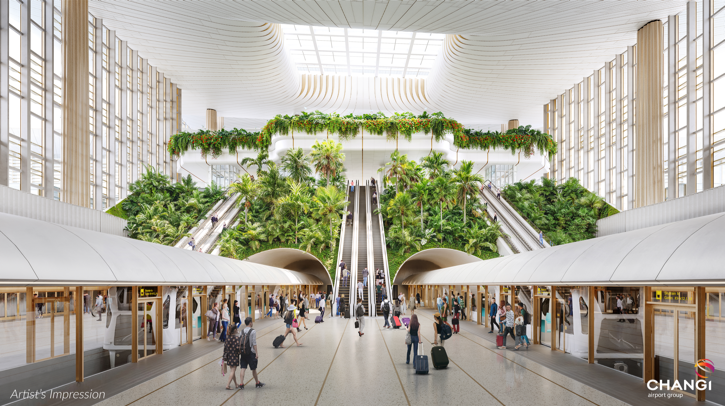Singapore’s Prime Minister and minister for finance, Lawrence Wong, has officiated at the groundbreaking ceremony for Changi Airport Terminal 5 (T5), a mega terminal that will handle approximately 50 million passengers annually in its first phase in the mid-2030s.
T5 will be linked to existing terminals at Changi Airport so that the airport can operate as a single integrated air hub. Powered by extensive automation, T5 will increase Changi Airport’s handling capacity and help it optimize operations and leverage new opportunities as travel demand continues to increase in the decades ahead.
The Singapore Airlines Group, which currently operates across three terminals, will consolidate its operations under one roof at T5. There will also be room for other air carriers to expand their operations at T5 and Changi’s other terminals.
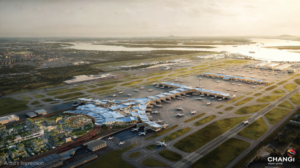
T5 is located in Changi East, a 1,080ha development which also includes the Changi East Industrial Zone (CEIZ), and the Changi East Urban District (CEUD). The CEIZ is aimed at augmenting Singapore’s position as a leading aircraft maintenance and integrated logistics and air cargo hub in the region, while the CEUD will serve as a vibrant business and lifestyle destination located at the doorstep of T5.
Enhanced connectivity
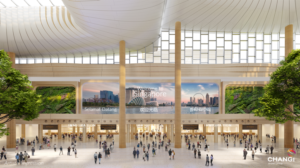
For the first time, T5 will see Changi Airport house a ground transportation center, bringing together train, bus, taxi and other transportation services. It will enhance Changi’s connectivity to the rest of Singapore, making the airport accessible not just for travel but also as a destination for local residents to enjoy. Plans are in progress to extend both the Thomson-East Coast Line and the Cross Island Line to T5 and connect it to the city center and other major hubs. T5 will also offer connections to neighboring destinations via ferry services.
A terminal of the future
T5 will see extensive automation of both passenger-facing processes and back-end functions, powered by technologies that are being trialled for wider implementation by the time T5 opens. This is intended to enable the airport to operate technologies at scale in a sustainable manner, with reduced reliance on manpower.
In addition, T5 will be a Green Mark Platinum Super Low Energy building. It will be powered by clean energy to reduce the carbon footprint of Changi Airport and be equipped with building management systems that feature efficient systems design. The terminal’s rooftop solar system, which will be one of the largest in Singapore, will have the potential to generate enough energy to power up about 20,000 four-room HDB flats for a year.
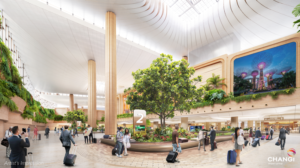
A mega-yet-cozy terminal
Inspired by Singapore’s blend of nature and city, T5 has been designed with a collection of overlapping curved roofs with varying heights. The ‘roof leaves’ break the mega terminal building into smaller spaces that are more human-scale, the airport says.
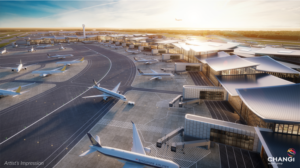
To make it easier for passengers to get around the terminal, travellators and an automated people mover (APM) system (similar to the Skytrain) will reduce walking distances. According to the airport, the walking distances in T5 will be comparable to Changi’s current terminals. The APM network will also link T5 to Terminal 2, facilitating transfers to the other terminals.
T5 is also designed to be intuitive for wayfinding, with paths that lead passengers either to the boarding gates or the APM station, where trains will take them to their gates. Therefore, passengers will not need to rely so heavily on signage to find their way around the terminal, the airport explains.
Yam Kum Weng, CEO of Changi Airport Group (CAG), said, “Our vision is for T5 to be mega yet cozy, a terminal that embraces the Changi DNA – delivering a personalized, stress-free and positively surprising airport experience. As a new gateway to Singapore, T5 offers new possibilities and will bring new surprises. It will offer yet another vibrant space for families, friends and the airport community to gather and bond.”
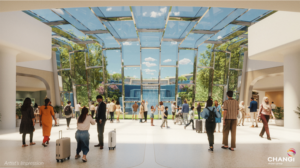
The design of T5 was proposed by a consortium led by KPF Associates, in partnership with Heatherwick Studio and Architects61. The design work for T5 was paused in 2020 due to the Covid-19 pandemic and resumed in 2022. Incorporating lessons learned from the global pandemic, T5 will have the flexibility to operate as smaller sub-terminals when needed to facilitate the management of high-risk passengers. It will also feature systems such as contactless touchpoints that can help to reduce disease transmission.
Trent Tesch, design principal of KPF, commented, “With the groundbreaking of Changi Terminal 5, I couldn’t be more excited to see this visionary project come to life. Changi Airport Group has long been a global leader in redefining what an airport can be, proving that efficiency and experience are not mutually exclusive. With Terminal 5, we set out to build on that legacy, challenging the conventional model of airport design. Too often, airports are designed as pure machines for movement – efficient but impersonal, reducing passengers to mere numbers in a system. Instead, T5 is conceived as a vibrant microcity that is distinctly Singaporean – lush, layered and deeply human. It integrates nature, cultural discovery and moments of wonder, transforming travel from something to endure into something to enjoy. Rather than endless corridors and passive waiting, it offers spaces that engage, surprise and delight, proving that an airport can be more than just a gateway – it can be a destination in itself.”
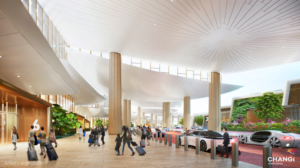
Thomas Heatherwick, design director of Heatherwick Studio, said, “We’re thrilled to be creating Changi’s Terminal 5, not just as an amazing airport terminal, but as an extraordinary collection of public spaces for the city. Inspired by the essence of Singapore, the terminal will be a place of lush greenery and characterful districts that redefine what an airport can be. And instead of building another monolithic transit hub, we’re making a unique place that you’d want to travel to, rather than just travel through – one that heartily welcomes both travelers and the local community.”
Chan Mun Kit, deputy CEO of Architects61, said, “Drawing on lessons learned from the pandemic, in a collaborative approach, Architects61 emerged well placed with the adoption of innovative and sustainable design solutions to meet the aspirations in T5. In this significant milestone to ground break T5, Architects61 is excited to embark on this journey with various disciplines to make this project a success.”
In related news, CAG recently awarded contracts for the substructure and airside infrastructure works at Changi Airport’s Terminal 5 (T5). These contracts are valued at about S$3.8bn (US$2.9bn) and S$950m (US$736m), respectively. Click here to read the full story

